So for my next foray into Animal Toy Blog I am going to discuss a full set of ten figures from a relatively new set from Safari Ltd, released in 2017 (but I only just discovered it…go figure). I’m going to come out and say, there will be brief parts (in point format) and longer parts (paragraphs) as I will discuss the toob figures individually (save two). Safari can and should do better, but the gems still make it worth getting.
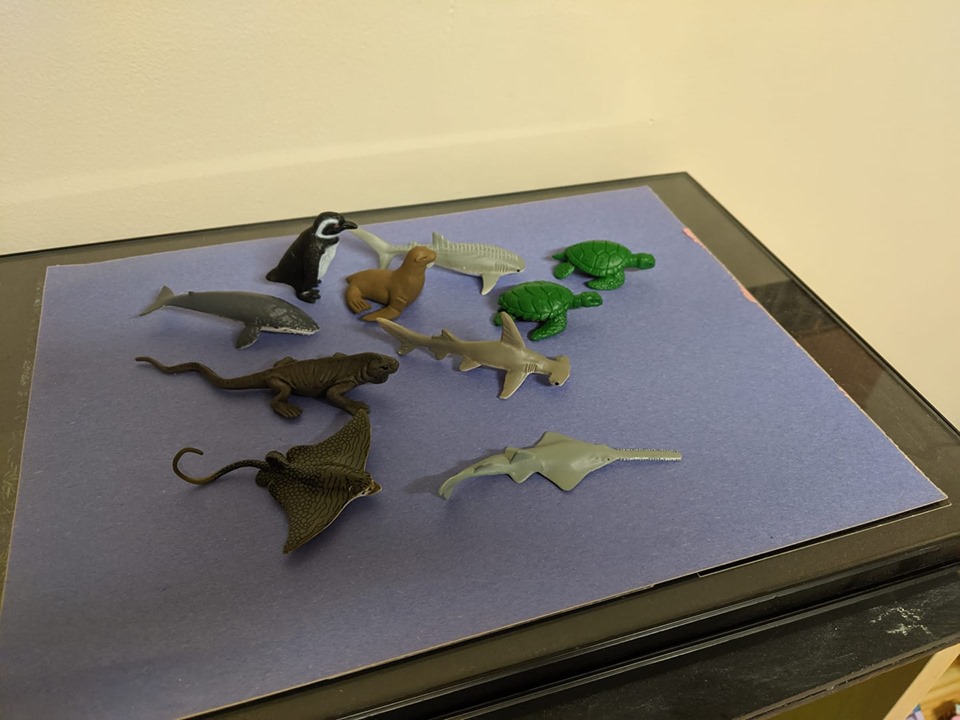
First impressions of the toob? Underwhelming. The majority of the figures are repeats from earlier toobs, most with repainting. Only one, the sawfish, is a new sculpt; the Ornate Eagle Ray is at least a new species from an original sculpt–I will give them more attention, as they are worth going on about a little. At the end. Have to build suspense. The figures are of course not to scale with each other.
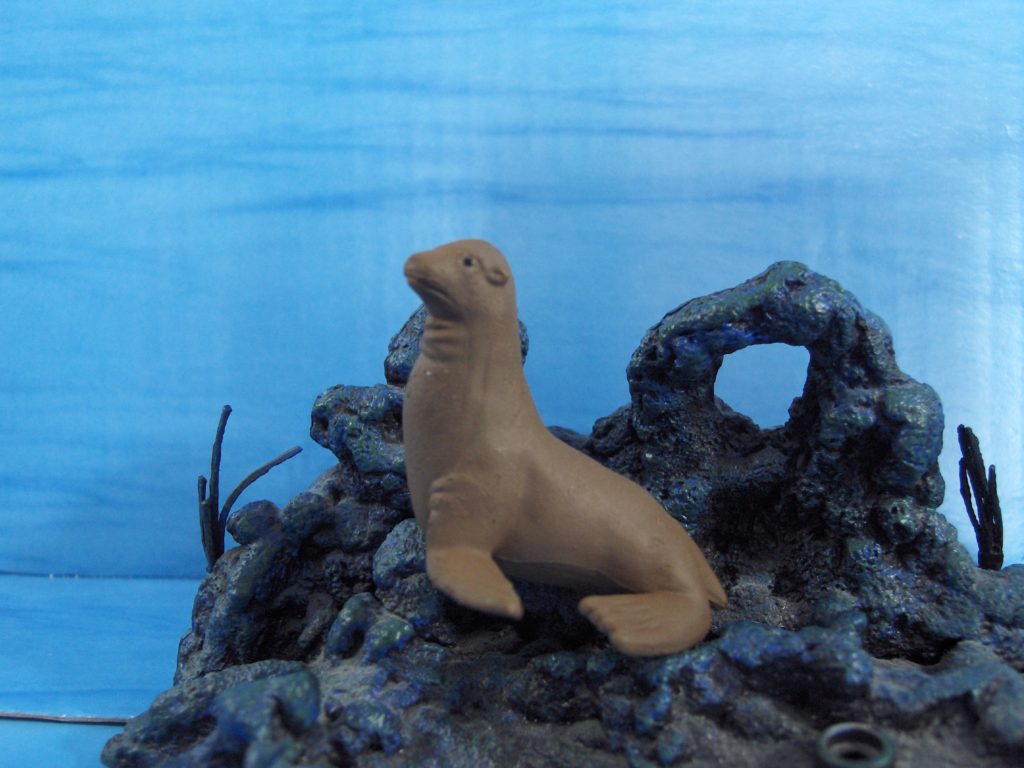
- Figure marked as: Sea Lion
- Species: Probably California Sea Lion, Zalophus californianus, but not identified to species
- Species is found: Pacific Coast of North America
- Relationships: Eared-seal family Otarriidae.
- Real Size: Males reach up to around 2.2 metres long.
- Figure size: 5cm along the back
- Scale: 1:44
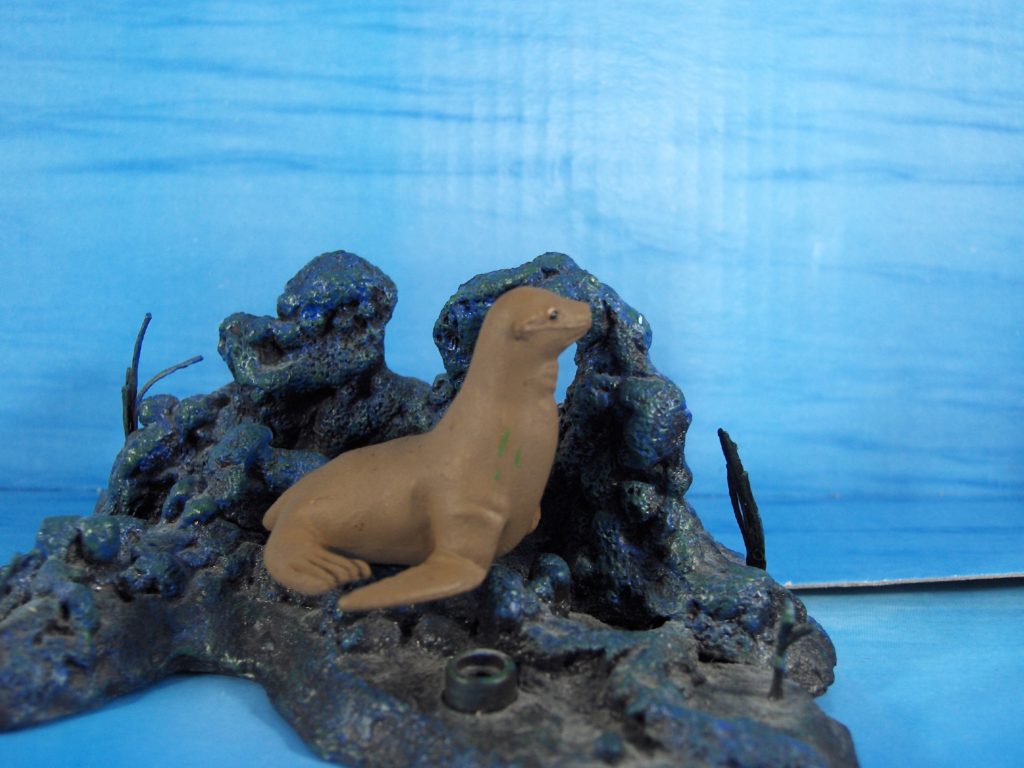
- Overall Colour and paint job: uniform dull brown (other than the green mis-paint I only noticed in the above photo).
- Detailing: The only highlighting is the black eyes, one of which (on mine) made it completely into the eye socket.
- Reissued from: the early Sea Life toob/Ocean.
- Overall impression: Rough sculpt work that was characteristic of early Safari toob figures. Colour is bland and not representative of natural shading from darker browns to lighter browns and chestnut colour
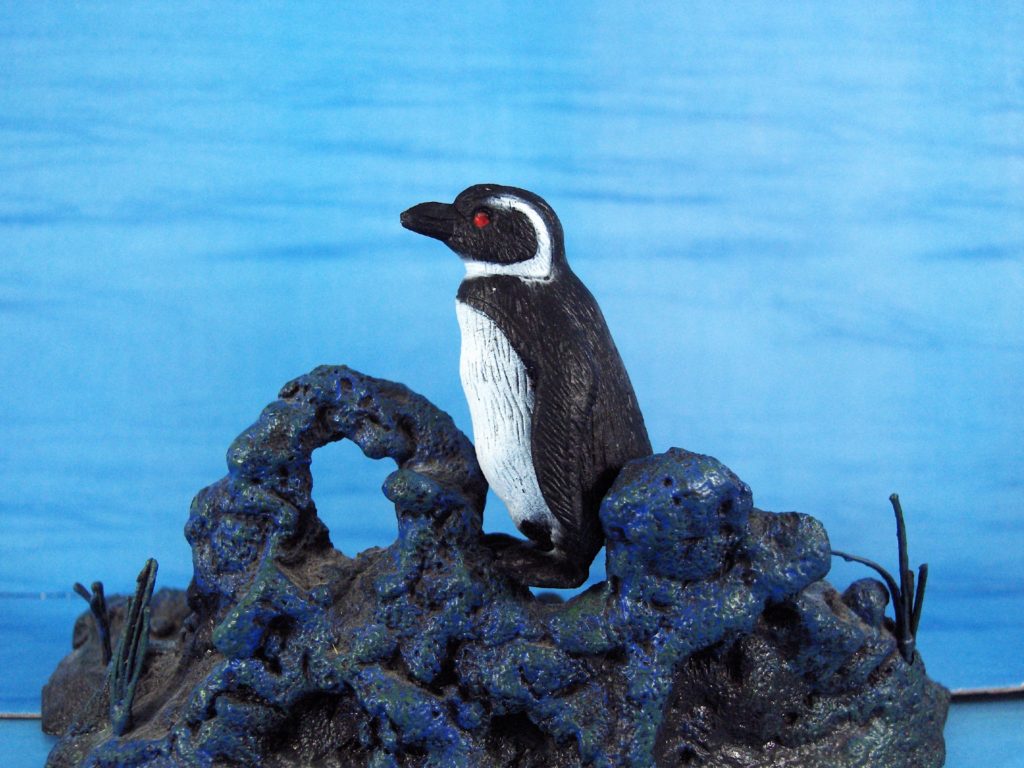
- Figure marked as: Galapagos Penguin
- Species: Spheniscus mendiculus
- Distribution: Galapagos islands. Some are found on the northern tip of the Island of Isabella making them the only penguin found north of the equator.
- Relationships: Penguins family Speniscidae.
- Real Size: About 50cm tall.
- Figure size: Stands about 4.3 cm high
- Scale: 1:12
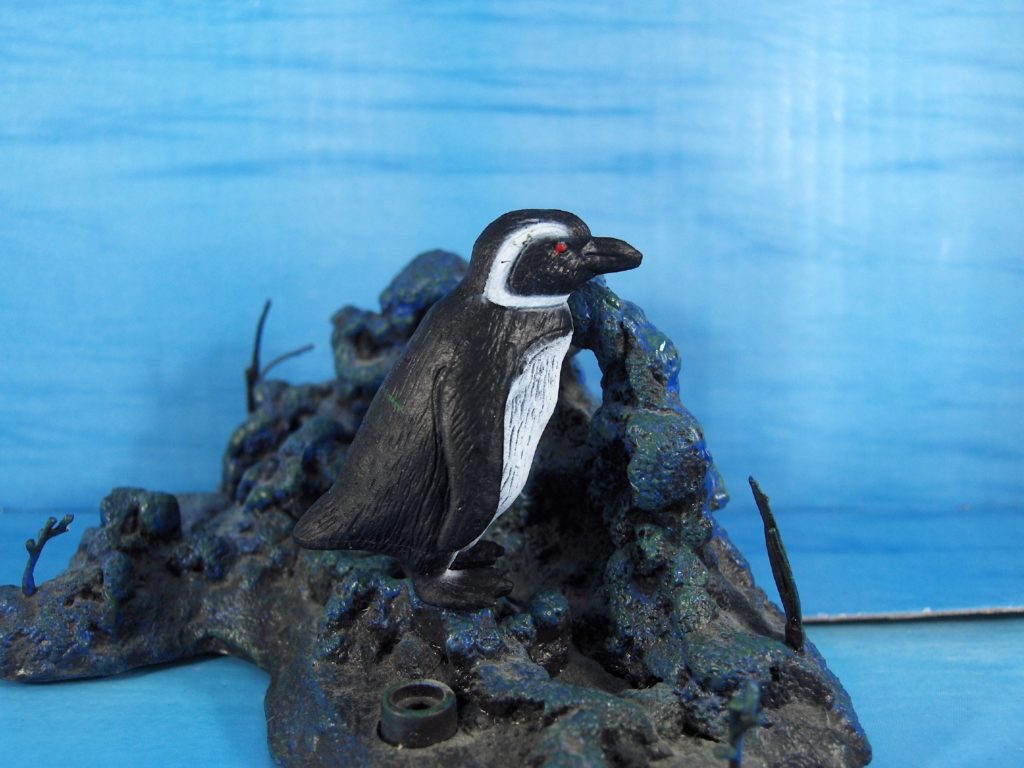
- Overall Colour and paint job: Characteristic Black and White penguin markings. Flat black overall with white belly and face mask
- Detailing: The white mask ringing the face is far too wide, and should be a more subtle, incomplete ring. The chest should also have a mottled black band near the top as well. Finally…those eyes. Why are they blood red dots? I could only find images with black or brown eyes.
- Reissued from: the Galapagos toob (2009) AND the Penguins toob (2010 AND the Pacific Toob from this year (2019). It has always looked like that.
- Overall impression: Easily recognizable as a penguin. It’s fine but not a great representation.
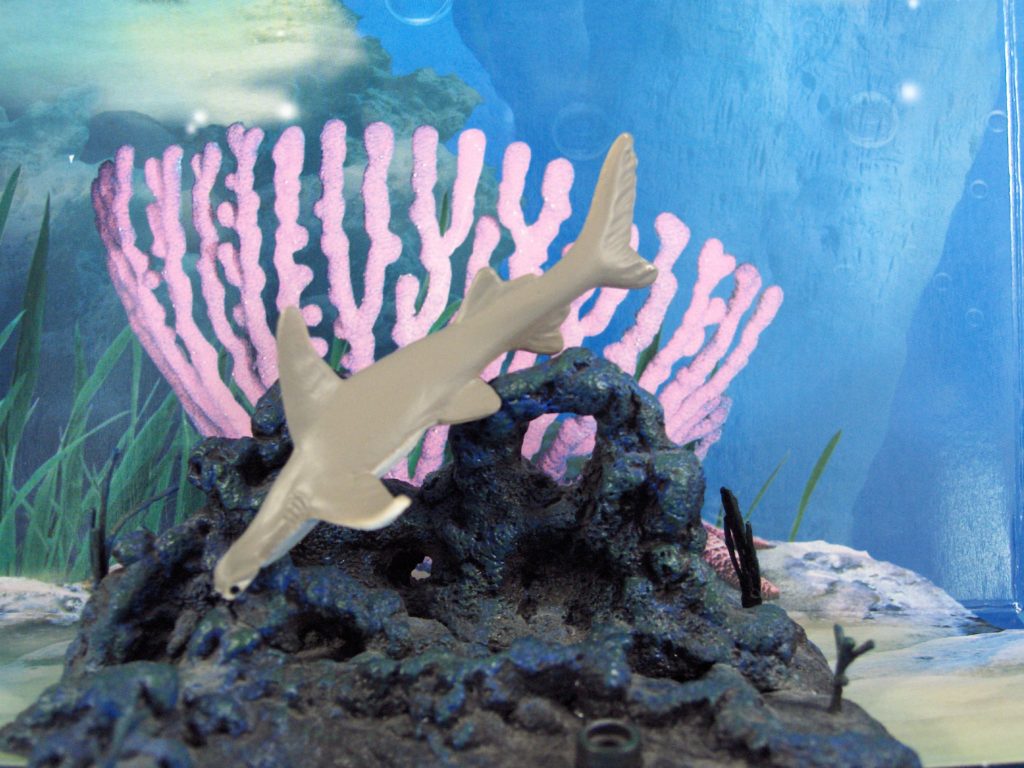
- Figure marked as: Great Hammerhead Shark
- Species: Sphyrna mokarran
- Distribution: Tropical ocean regions.
- Relationships: Hammerhead shark family Sphyrnidae, a very unique clade of Charchariniformes (the ground sharks)
- Real Size: Averages 3.1, records up to 6.1m.
- Figure size: 8 cm TL
- Scale: 1:44 or 1:76, depending on whether it’s a record breaker or not!
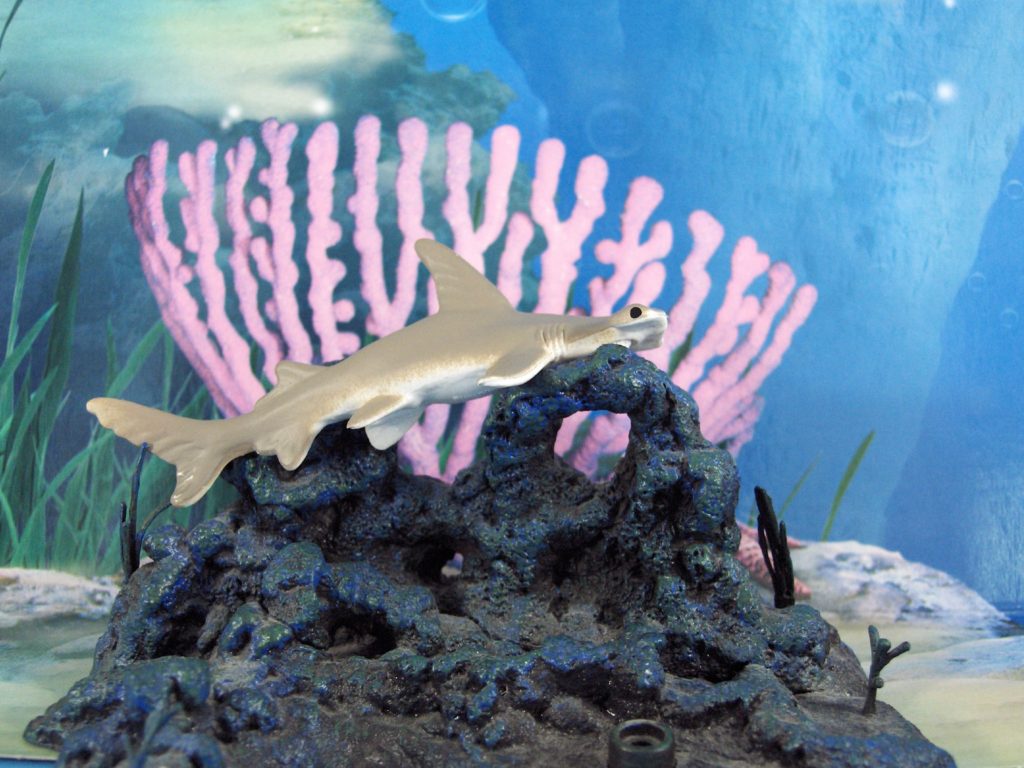
- Overall Colour and paint job: Flat taupe colouring, counter-shaded to white on the belly.
- Detailing: None to speak of. The sculpt is decent, with interesting details in the fins. The colour is uniform, with only the eyes being given any variation (black dots of course)
- Reissued from: the Ocean toob (pre-2001) AND the Sharks toob (pre-2004) but they did at least improve the paint job; it used to be more shiny brown all over.
- Overall impression: It’s fine. It’s a hammerhead shark. The head (“cephalofoil”) doesn’t feel wide enough to be a Great; the original toobs did not specify species, but this one does, leading me to believe it was originally based on a common hammerhead shark. As Wikipedia helpfully puts it, the cephalofoil should be 23%-27% of the body length (about 1/4). But it’s okay as a hammerhead shark, and at least they improved the paint job. The same can’t be said for…
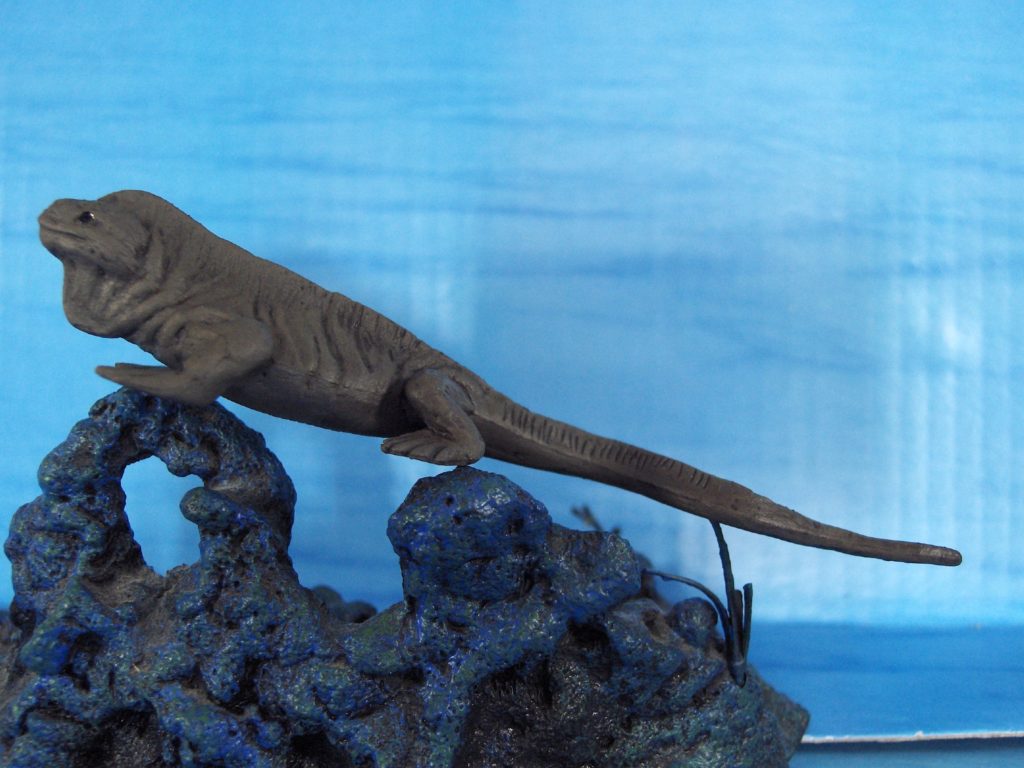
- Figure marked as: Marine Iguana
- Species: Amblyrhynchus cristatus
- Distribution: The Galapagos islands
- Relationships: the iguanas, Iguanidae. One of many lizard families–but the only marine foraging species!
- Real Size: Putting together listed snout-vent and tail lengths, up to 140cm
- Figure size: 10.8 cm (the giant of the toob!)
- Scale: 1:13
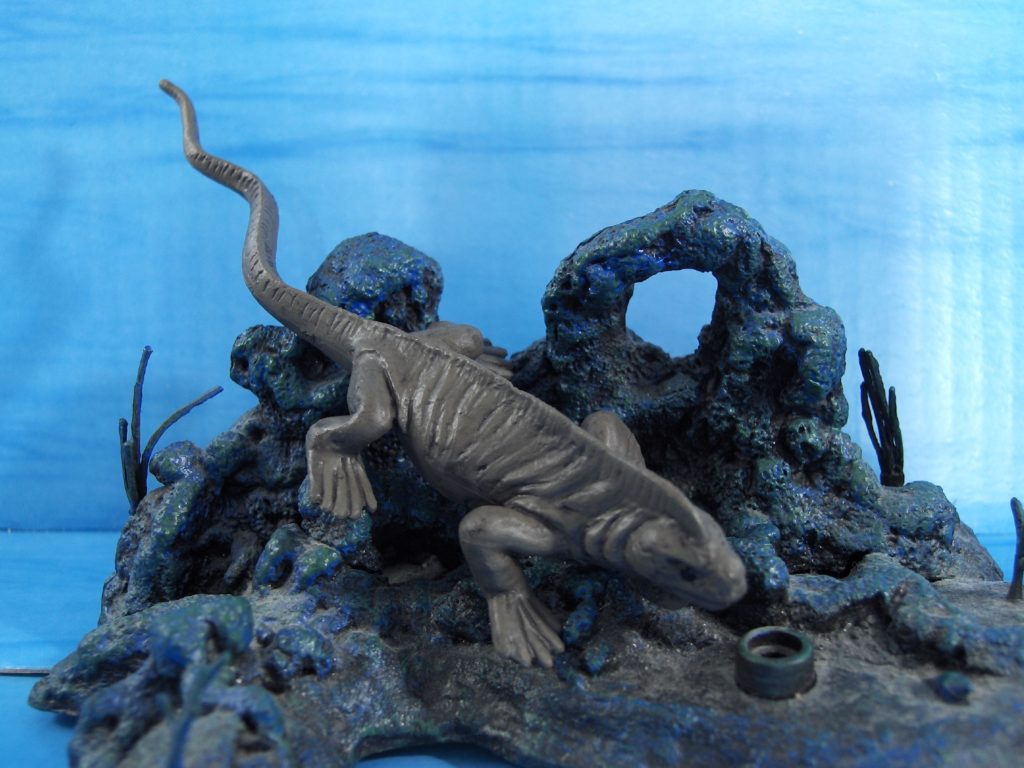
- Overall Colour and paint job: Flat, uniform dark taupe
- Detailing: Lots of sculpted wrinkles but only the eyes are, of course, black and shiny
- Reissued from: Galapagos toob (2009)
- Overall impression: I’m…not impressed. It would be great to have an affordable small model of such an interesting and unique lizard…but this isn’t it. The original model had more variety and colour in its palette, but even then left out the bold reds, blacks and greens seen in the living animals. Plus…it doesn’t look like a marine iguana. The snout is too elongated, there are no spikes sticking up around the back of the head and along the spine, and the throat pouch and head crest are not marine iguana-like (it looks familiar, but I can’t place it). If you need a marine iguana, try to find the (retired) Incredible Creatures one from Safari. It’s bigger but much closer to the real thing.
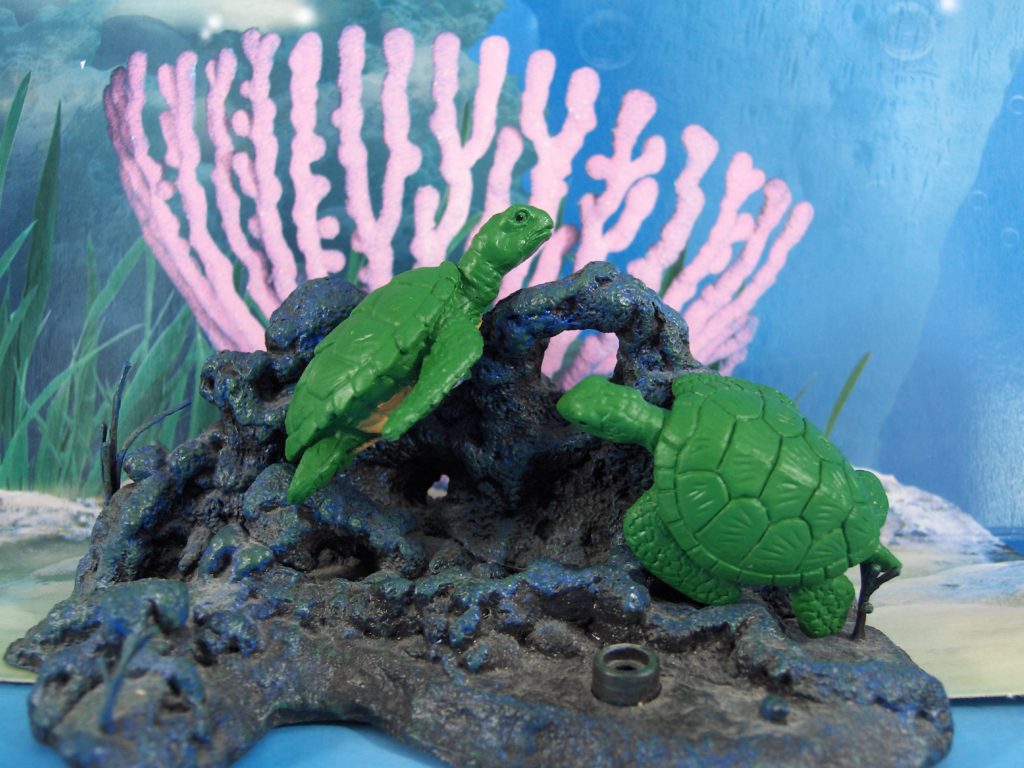
- Figure marked as: Hawksbill Sea Turtle and Kemp’s Ridley Sea Turtle
- Species: Eretmochelys imbricata and Lepidochelys kempii
- Distribution: Hawksbill is found in tropical ocean latitudes worldwide; the Kemp’s Ridley is found along the Atlantic coast of North America (as far north as New Jersey) and the Gulf of Mexico
- Relationships: Both are members of the sea turtle family Chelonidae, which includes all of the sea turtles except the Leatherback. I just learned this for you!
- Real Size: 94cm and 65cm carapace shell lengths, respectively for the Hawksbill and Kemp’s Ridley
- Figure size: 3.3cm and 3.6, respectively.
- Scale: 1:28 and 1:18
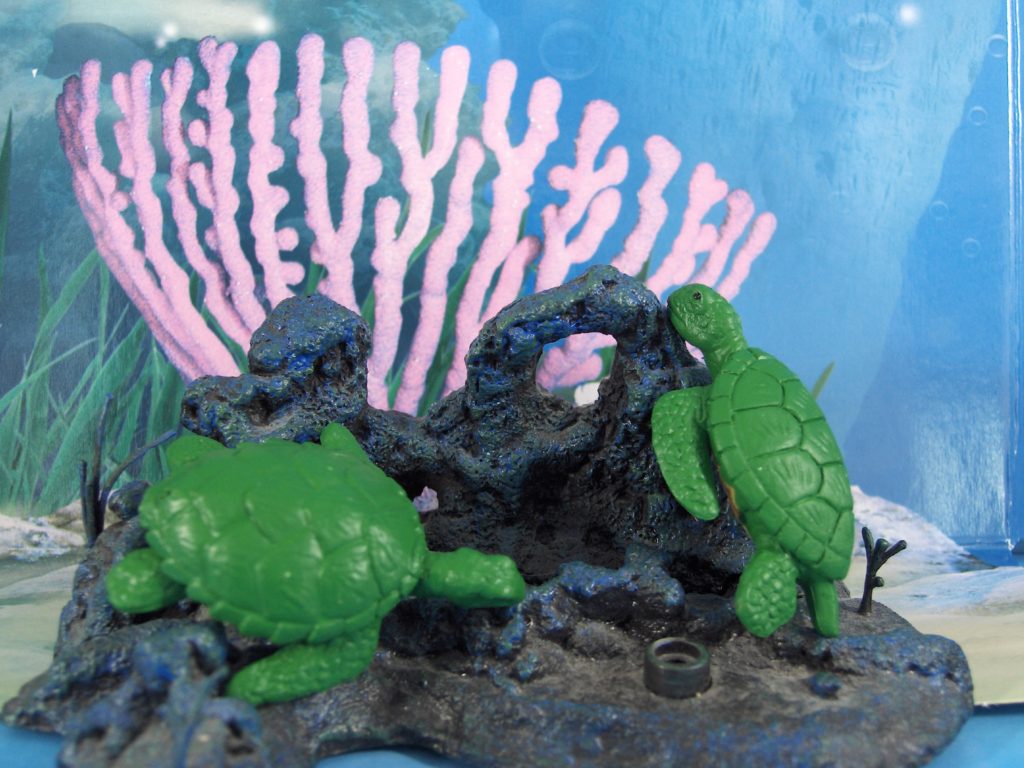
They are so non-distinct it’s really hard to know for sure. But they are marked on the belly.
- Overall Colour and paint job: They are both a uniform bright green overall on the shell, head, tail and flippers. The plastron on both is a light orange colour. Other than the accidental green paint splatter.
- Detailing: None. Just the tiny black eye dots.
- Reissued from: The retired Frogs and Turtles toob (2003)
- Overall impression: They’re terrible. They don’t look right for the turtles they represent–and if I hadn’t seen the species’ markings on the bellies, I would have never guessed the species. In fact, what is here marked as the Kemp’s Ridley was marked as the Hawksbill in the original toob; the one now marked as a Hawksbill was the Green Sea Turtle. Neither is painted to look like their labelled species (Hawksbills are much darker, Kemp’s are kind of a lighter bluish-green and neither is uniform in colour). To say nothing of the ridged shell on the Kemp’s.
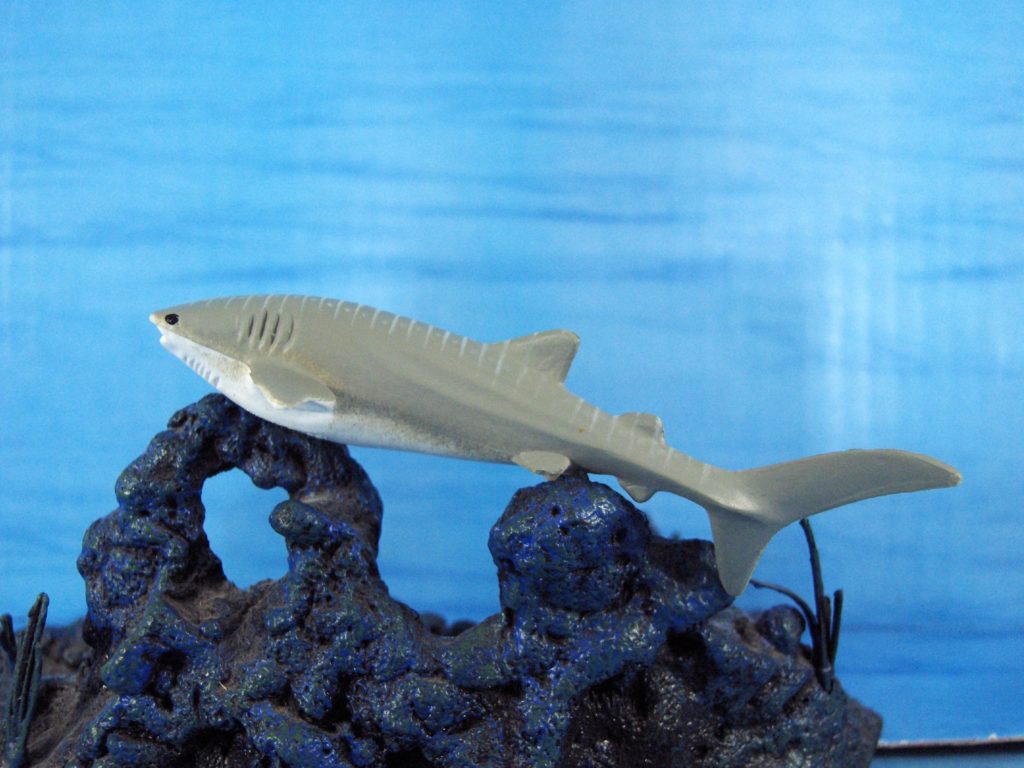
- Figure marked as: Whale Shark
- Species: Rhincodon typus
- Distribution: Tropical latitudes in the world’s oceans
- Relationships: Only member of the montypic family Rhicodontidae, part of the order Orectoboliformes, the Carpet Sharks (side note…we need more figures of this order)
- Real Size: It’s the largest non-whale in the world, so of course reports of record sizes are all over the place. Average seems to be about 9.8m, with verified lengths of over 12m. A large female was reported to be over 18m!
- Figure size: 8.3cm
- Scale: Again, this can be all over the place. Using the average, 1:118. Using the large verified of 12m, 1:145. And using the huge reported size of the 18m female (and this model is a female), 1:217. Essentially, whatever you need it to be. Whale sharks are big, and the figure is small.
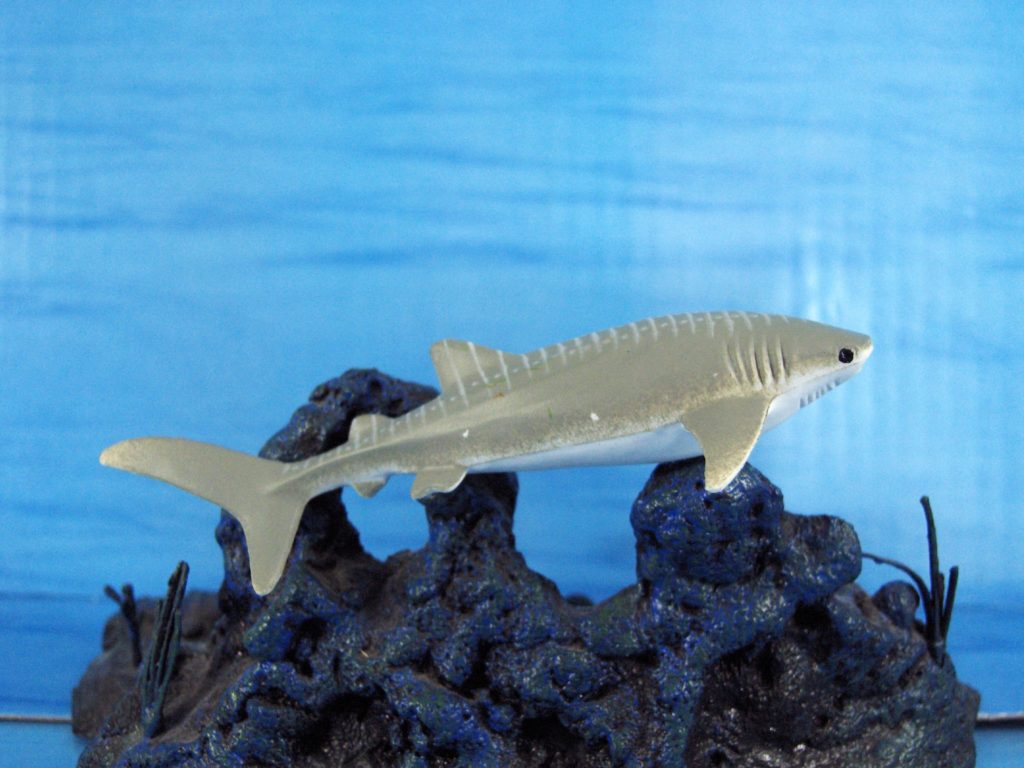
- Overall Colour and paint job: Very grey, blended to a white counter-shade on the belly
- Detailing: Some attempt at the distinctive spots and longitudinal stripes pattern, but it should cover the whole dorsal surface. There is also some attempt to capture the ridge-like patterns along the body.
- Reissued from: The Sharks toob (pre-2004). And also the 2019-released Pelagic Fishes toob. There is some slight variation, but overall they appear to be the same figure.
- Overall impression: It’s okay as a whale shark. It could stand to be a little more compressed (it’s kind of bulging) and the colour could be made more true to life (I’ve swam with them, they’re more bluish) with a lot more patterning.
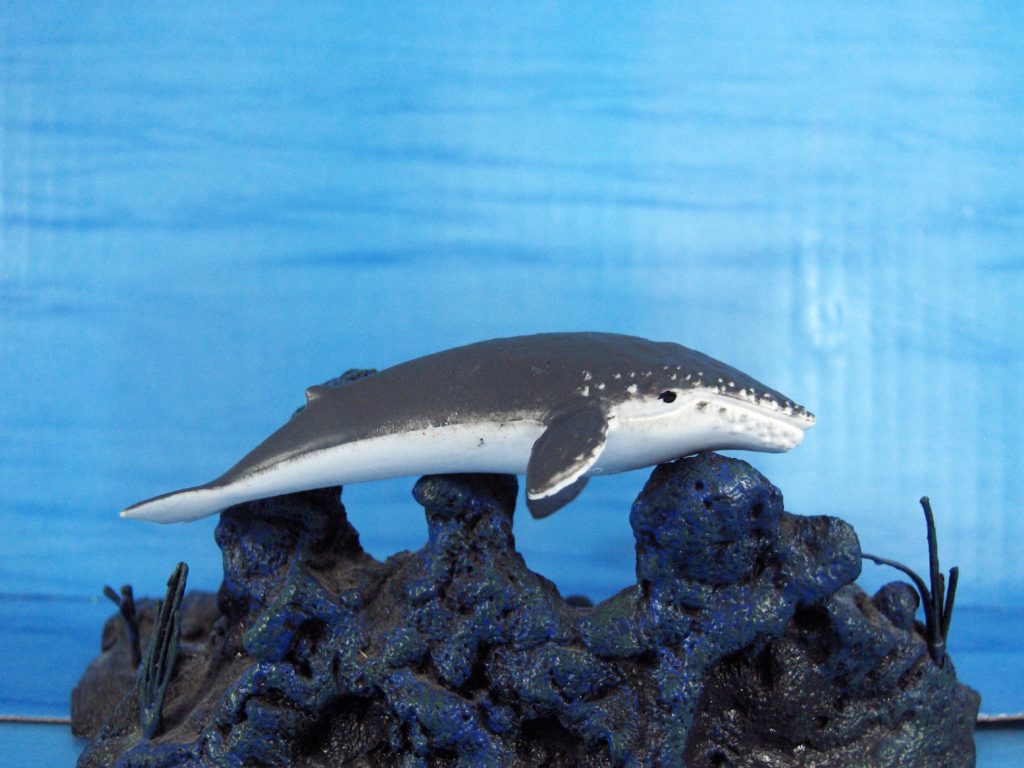
- Figure marked as: Blue Whale
- Species: Balaenoptera musculus
- Distribution: Oceans worldwide
- Relationships: Rorqual whales family Balaenopteridae, one of the baleen whale families
- Real Size: Almost 30m long.
- Figure size: 6.2cm
- Scale: 1:484
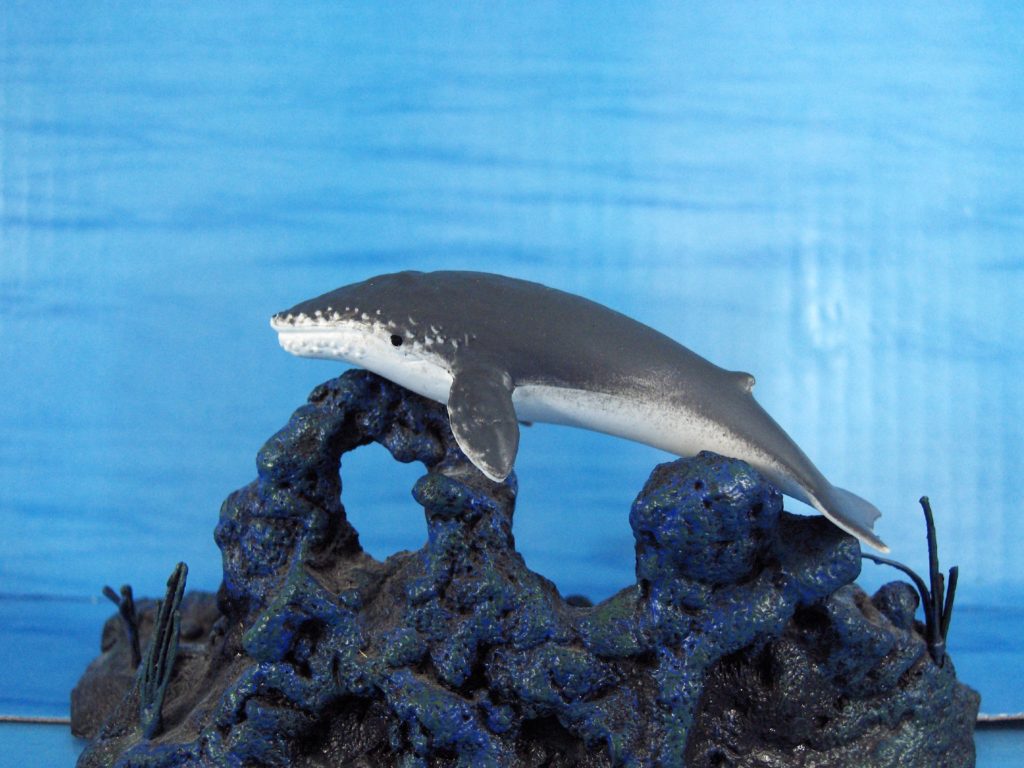
- Overall Colour and paint job: Well…it’s not blue. It is a dark grey on the back, countershaded to white on the underside.
- Detailing: There is no special paint application on the figure. There are barnacles sculpted in, but these are painted the same as the whale (or left white…)
- Reissued from: The Whales & Dolphins toob (2003). But with a far more muted colour scheme (the original was at least blue, but it had white spots!)
- Overall impression: Honestly, my first impression is that it doesn’t look like a blue whale. The proportions are off, the head is wrong, the body shape is weird…maybe it looks like some kind of rorqual, but not a blue whale (I’m ignoring the colour). But there’s good news for whale fans–in 2018 they released a much better, more accurate Whales toob including a very good little blue whale. What a difference a year makes.
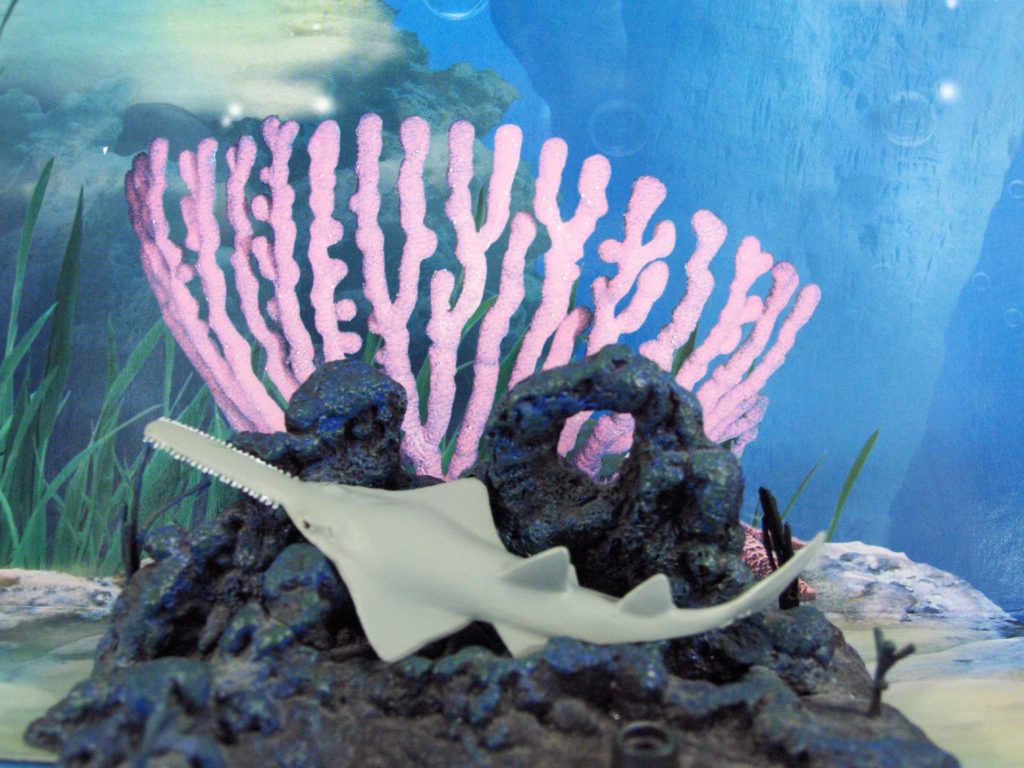
Okay, this is a figure worth some paragraphs. This figure is marked as a sawfish; unlike the others, there is no specific name given, but it’s possibly a longcomb or green sawfish Pristis zijsron (Bleeker, 1851) based on the placement of the dorsal relative to the pectorals, the flattened body, and the 24 pairs of teeth on the rostrum–that’s right, each tooth is individually sculpted! It’s one of 5 living species in the family Pristidae, a family of rays notable for their enlongated rostra lined with teeth. Overall, sawfish are having a hard time surviving in the modern world, with all being either Endangered or (like the Longcomb) Critically Endangered.
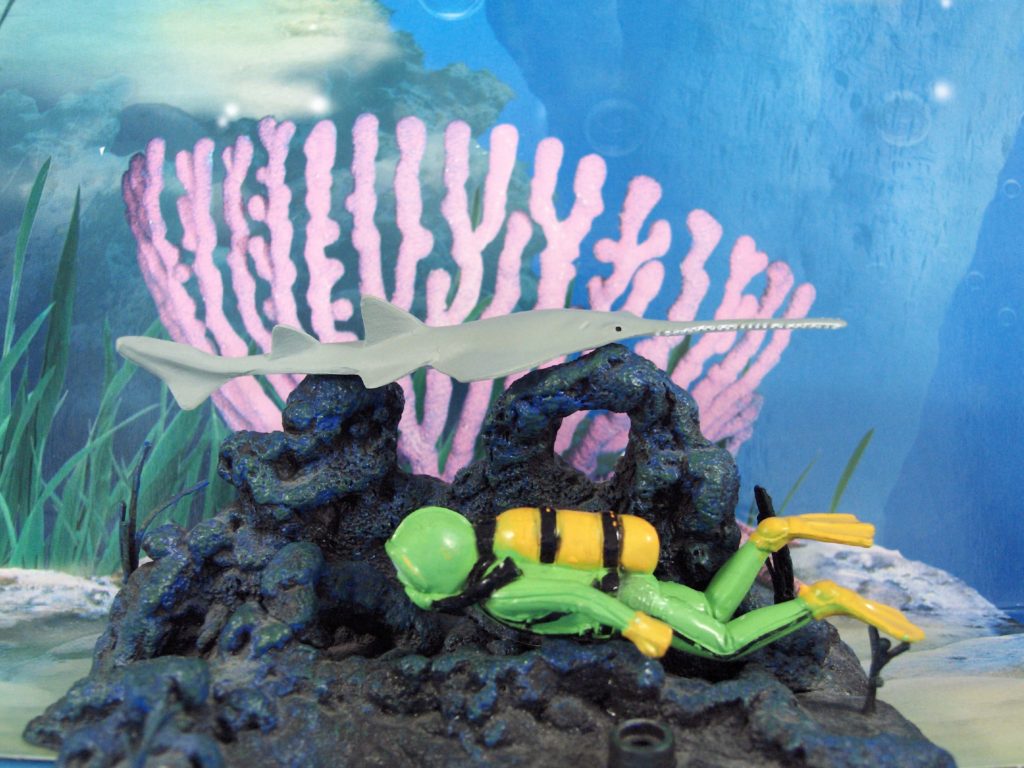
The longcomb sawfish is found in Indo-Pacific waters, in mangroves, estuaries and coastal areas, although it can be found further into open water and inland in rivers. They reach about 6 metres in length (historically up to 7.5m). The figure is 9.5cm, making the scale 1:63.
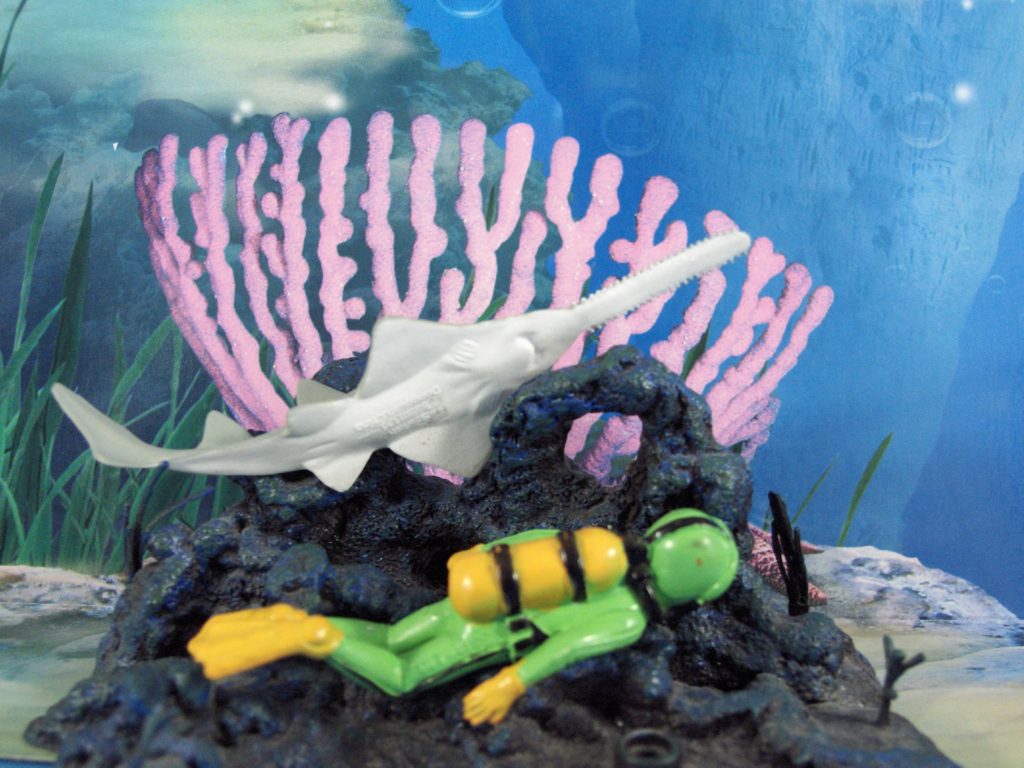
This figure is the only entirely unique model in the entire toob–the sculpt is definitely a new one, and the recent sculpting is apparent. The lines are clean and crisp, and the sculpted detail is well placed. The paint job is a plain grey on the dorsal surface with a sharp delineation to a white underside. The rostral teeth are white on both surfaces. Overall, this is a very good figure for a toob, and I hope it means an updated Sharks toob is coming!
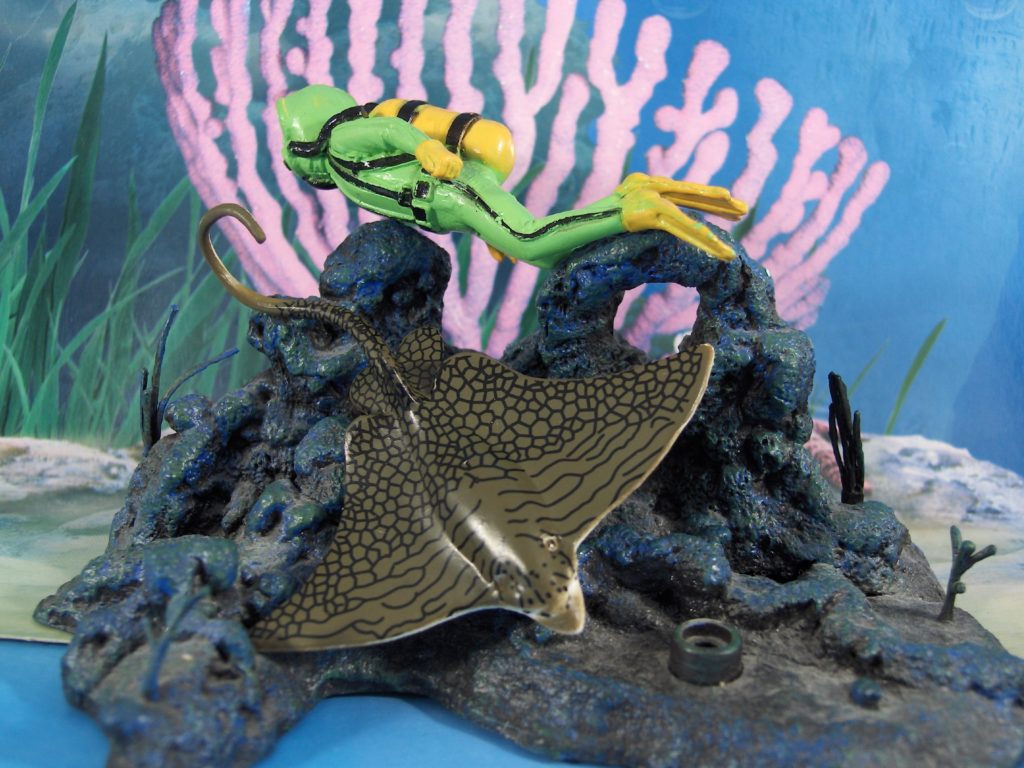
So here it is…the reason I bought the toob. The sculpt is not new–there have been multiple releases of the figure in different paint schemes over the years (in the pre-2003 Ocean toob). But they went all out with this paint job to produce a unique and striking figure of an Ornate Eagle Ray Aetomylaeus vespertilio. This ray is a member of the eagle ray family Myliobatidae, notable for being highly active, pelagic rays. Ornate eagle rays are considered endangered, and are not encountered very often.
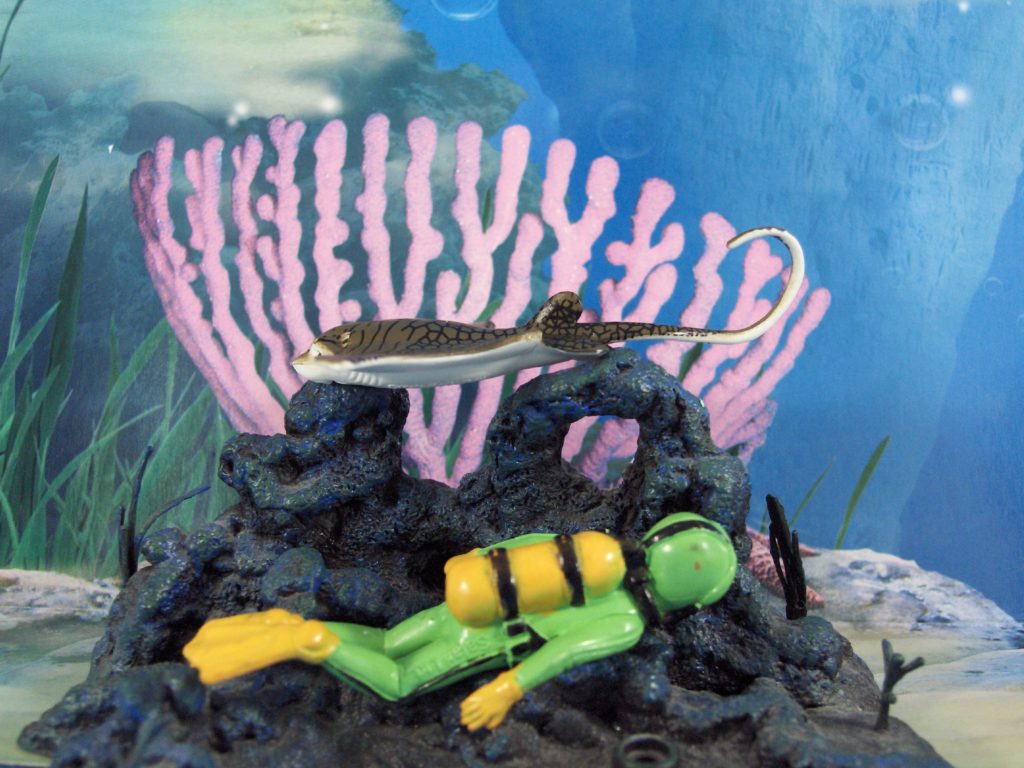
Ornate eagle rays are found scattered throughout Indo-Pacific waters. They inhabit muddy bays and coral reefs. The wingspan of the Ornate eagle ray is 240cm; the figure is 6cm across. This gives it a scale of 1:40 (the magical figure collection number!).
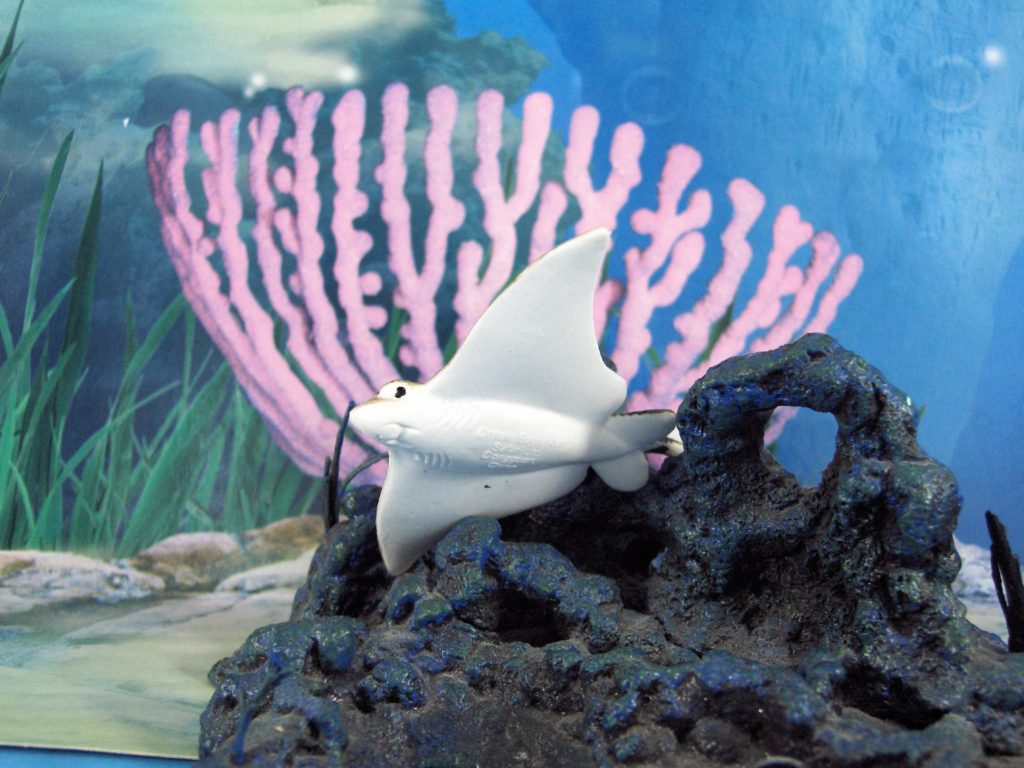
As the final figure in this toob, this figure, to me, makes it worth adding to your collection (or toy box). I have had a lot to say about the paint work on most of this toob–but they spared no effort in reflecting the bold dark green body of this ray, with the distinct thin lines toward the front, and honeycomb patterning from the back half of the body and down toward the middle of the tail. The eyes and nostrils are picked out in black (of course) but the spiracles are left distinctly unpainted. The belly is left white, where the mouth and and gills are clearly sculpted (although this is from the original sculpt). Overall, this figure is Safari toob figures at their best–superb attention to detail in the paint job, and representing an uncommon but very cool animal as a figure (spotted eagles get all the attention).
Final thoughts? Not going to mince words, 8 of the ten figures are disappointing and will probably not stay in my collection. There are so many endangered marine animals that could really use attention…or deserve better representations. But the Sawfish and the Ornate Eagle ray are absolutely worth adding to a collection. They are definitely going on my display shelf!
Disclaimer: links to Ebay and Amazon on the AnimalToyBlog are affiliate links, so we make a small commission if you use them. Thanks for supporting us!




What an interesting mix of ‘Yeah’ and ‘No Way’. The clear losers, to me, are the ‘marine’ iguana (clearly a green iguana was the influence for the sculpt), the ‘blue’ whale (which appears to be modeled after a humpback or gray whale), and the two turtles which, if not for this review, I would have thought were the same sculpt without looking extra close!
The ray is fantastic. And not only the paint application, but the size makes it comparable for ‘standard-sized’ figures as well!
There is a store in San Francisco that sells TOOB figures individually; next year if I go out for a baseball game I’ll have to check for this ray 😉
Do they break the toobs open? It usually takes Safari a few years to make bulk bags.
If they do have them, see if they have the endangered land animals figures; there’s a really nice African Wild Dog, but the rest of the toob is the terrible original wild animals. But if you see it, pick up one for me!
oh yeah, they might be from bulk bags. I’ll check regardless
Not for nothing, I break the TOOBs up and sell them individually when possible. There are always a few figures from each TOOB that don’t move, but the “exclusives” that Safari is starting to offer make buying the whole TOOB a pain for collectors, and I take pity on them. I think I still have one or two of the African Wild Dog figures from the Endangered Land Animals TOOB available, as well as the Snow Leopard (also a new sculpt for the TOOB figures). Both of those were originally sculpted by Doug Watson for the Wild Safari line, and the TOOB figures do a nice job of capturing the original sculpt. I love the fact that Safari has “reissued,” so to speak, the long-retired Monterey Bay Aquarium Smalltooth Sawfish (somewhere I have the little collector’s book that has it labeled as the Smalltooth Sawfish ([i]Pristis pectinata[/i]); I won’t vouch for the accuracy of the sculpt to represent that species, since sawfish are notoriously similar to one another). And I think they are brilliant for including the Ornate Eagle Ray.
I also like the Great Hammerhead offered in this set vs. the one in the other TOOBs – it’s paintjob is 100% more realistic (Great Hammerheads are a kind of pale gray-brown or mushroom/olive color). The head size may be the tiniest bit too small (i believe the head is about 17mm, so it’s about 21.25% of the total body length), but the accurate dorsal fin that lacks the great big glob of plastic at the tip makes this all the more worthwhile. It definitely looks like they updated the mold for this one (see how crisp the gill slits look, that dorsal fin is nice and sharp, and even the mouth and teeth are very evident). It is 100% a Great Hammerhead – despite it’s head size being slightly small. That nice, flat head with just the slightest scalloping and the deep notch in the middle, the extremely tall, sharp dorsal fin, the large pectorals…. It is a decent representation of the species. … Look at me going all out to defend the Hammerhead figure haha. Also, the Whale Shark figure looks like it has received a similarly updated mold, as it is much crisper in appearance than the figures in the previously released TOOBs.
I eventually found a Land animals set. Relatively cheap. Let’s just say that even the exclusives in the toob aren’t their best work.
To say nothing of the ‘ARMUR’ leopard.
Good review. Might want to add ‘Reptiles’ to the tags due to the sea turtles.
Added it! Nice catch; not surprising I missed at least one.
I would love to buy the fabulous Ornate Eagle Ray alone without all the other mess! I don’t mind if it’s 1:40, it may be a juvenile. I need this ray!!!!!
Just want to tell you, you spelled the species name of the blue whale, musculus, incorrectly.
But I can understand what you think. Most figures from here are reissued from previous tubes. I particularly like the sawfish and the repainted eagle ray, but not much else.
Thanks for catching that! I edited it!
Very strange, that penguin is actually not the one from the Galapagos toob! That one has no facial ring at all and a much more upright posture.
https://cdn.shopify.com/s/files/1/2259/5719/products/l100046317.png?v=1534347894
Hey Stargatedalek, I didn’t see your comment until now.
The figure is marked as a Galapagos, but now that you said it, you are correct–I think this is the same as the Galapagos penguin in the Penguins toob, not the Galapagos toob.